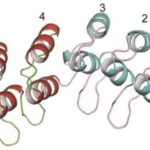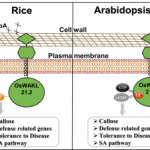Water Pass: the aquaporin ZmPIP2:5 contributes to water transport at the gatekeeper cells
Magdalena M. Julkowska, King Abdullah University of Science and Technology, Thuwal, Saudi Arabia, ORCID: 0000-0002-4259-8296
Water transport is essential for many physiological processes in vascular plants. One of the forces driving water transport across roots is provided by the tension created by transpiration from the shoot, which extends to the root xylem. On the cellular level, water can be transported between cells through plasmodesmata (symplastic path), intercellular spaces (apoplastic path) or across membranes (transcellular path). Water follows the path of least resistance, which often means flowing through the apoplast and usually-hydrophilic, cell walls (Steudle and Frensch, 1996). When the water arrives at the exo- or endodermal layer, where the Casparian strip makes the cell wall hydrophobic, it is forced to move through the transcellular path, which relies on the membrane-localized aquaporins. Aquaporins are small membrane proteins that form channels permeable to water and other small uncharged molecules. Plant aquaporins are a large family of proteins that vary in their sub-cellular localization and site of expression (Deshmukh et al., 2016). While aquaporin abundance in the membrane is regulated through post-transcriptional modifications (Santoni, 2017), it is still unclear how individual aquaporins contribute to the overall hydraulic conductivity of the plant.
Ding et al. (2020) explored how the most abundant maize (Zea mays) root aquaporin, ZmPIP2;5, affects hydraulic conductance at the cell, root and leaf levels using knock-out and overexpression lines. Overexpression of ZmPIP2;5 increased hydraulic conductivity of individual cells, (cortical cells and mesophyll protoplasts), but it did not increase hydraulic conductivity of the entire root (Ding et al., 2020). This discrepancy between cell and tissue hydraulic conductivity was hypothesized to be due to the non-uniform water permeability of individual cell layers. While ZmPIP2;5 is expressed in all root cells, its expression is enriched in the gatekeeper cells of endo- and exodermis (Hachez et al., 2006). Assuming that the aquaporin abundance at these gatekeeper cells is the limiting factor for radial water conductivity, the increased expression in other cell types is not likely to contribute to the overall root conductivity.
The above hypothesis was examined using the Model of Explicit Cross-section Hydraulic Architecture (MECHA) model (Couvreur et al., 2018), which integrates among others root anatomy and plasma membrane conductivity, to predict the root’s radial hydraulic conductivity. In a MECHA model where the aquaporin abundance is already saturated in the gatekeeper cells, but not in other cell types, predicted that overexpression of the aquaporins in the entire root will not additionally increase the root conductivity. Interestingly, MECHA also predicted a significant reduction in the overall root conductivity, which was observed for the knock-out lines.
Because hydraulic conductivity changes in response to external factors, the plant’s water use efficiency can be compromised under stress conditions. Therefore Ding et al. (2020) examined the leaf elongation rate under moderate water deficit conditions. Interestingly, overexpression lines showed increased leaf elongation rate compared to wild-type plants, suggesting increased leaf water permeability. This effect on leaf elongation rate was not observed in knock-out lines, possibly because ZmPIP2;5 is not expressed in shoot tissue under normal conditions. The gatekeeper cells in the leaf are the suberized cells around the vasculature, which usually express different aquaporin genes, not ZmPIP2;5 (Hachez et al., 2008).
Although vascular aquaporins have previously been associated with increased water use efficiency (Sade and Moshelion, 2017), experimental evidence for fine-tuned expression of aquaporins in stress tolerance under controlled or field conditions is yet to be demonstrated. The work by Ding et al. (2020) opens up new possibilities, suggesting the importance of tissue-specific overexpression of aquaporins in gatekeeper cells for more fine-tuned modification of hydraulic conductance and more crop per drop.
References
Couvreur V, Faget M, Lobet G, Javaux M, Chaumont F, Draye X (2018) Going with the Flow: Multiscale Insights into the Composite Nature of Water Transport in Roots. Plant Physiol 178: 1689–1703
Deshmukh RK, Sonah H, Bélanger RR (2016) Plant Aquaporins: Genome-Wide Identification, Transcriptomics, Proteomics, and Advanced Analytical Tools. Front Plant Sci 7: 1896
Hachez C, Heinen RB, Draye X, Chaumont F (2008) The expression pattern of plasma membrane aquaporins in maize leaf highlights their role in hydraulic regulation. Plant Mol Biol 68: 337–353
Hachez C, Moshelion M, Zelazny E, Cavez D, Chaumont F (2006) Localization and quantification of plasma membrane aquaporin expression in maize primary root: a clue to understanding their role as cellular plumbers. Plant Mol Biol 62: 305–323
Sade N, Moshelion M (2017) Plant Aquaporins and Abiotic Stress. In F Chaumont, SD Tyerman, eds, Plant Aquaporins: From Transport to Signaling. Springer International Publishing, Cham, pp 185–206
Santoni V (2017) Plant Aquaporin Posttranslational Regulation. In F Chaumont, SD Tyerman, eds, Plant Aquaporins: From Transport to Signaling. Springer International Publishing, Cham, pp 83–105
Steudle E, Frensch J (1996) Water transport in plants: Role of the apoplast. Plant Soil 187: 67–79



